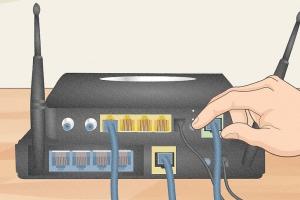Step-by-Step Guide: Connecting Your VoIP Phone to a Router Easily

-
Quick Links:
- Introduction
- Understanding VoIP Technology
- Requirements for Connecting a VoIP Phone
- Step-by-Step Setup Instructions
- Common Issues and Troubleshooting
- Case Studies of VoIP Implementations
- Expert Insights on VoIP Connectivity
- Conclusion
- FAQs
Introduction
Voice over Internet Protocol (VoIP) has revolutionized the way we communicate, enabling users to make calls using the internet instead of traditional phone lines. Understanding how to connect a VoIP phone to a router is essential for maximizing the benefits of this technology. This guide will walk you through the process, providing expert insights, troubleshooting tips, and more.
Understanding VoIP Technology
VoIP technology converts voice signals into digital data packets and transmits them over the internet. This method is not only cost-effective but also flexible, allowing users to make calls from anywhere with an internet connection.
Some key advantages of VoIP include:
- Lower costs for long-distance and international calls.
- Advanced features such as voicemail-to-email, call forwarding, and video conferencing.
- Scalability for businesses, allowing easy addition of users.
Requirements for Connecting a VoIP Phone
Before connecting your VoIP phone to a router, ensure you have the following:
- A VoIP phone that supports SIP (Session Initiation Protocol).
- A compatible router, preferably with Quality of Service (QoS) features.
- An active internet connection with sufficient bandwidth.
- VoIP service provider details, including SIP server address, username, and password.
Step-by-Step Setup Instructions
Follow these detailed steps to connect your VoIP phone to your router:
Step 1: Gather Your Equipment
Ensure you have all necessary equipment at hand:
- VoIP phone
- Router
- Ethernet cable
- Power supply for the VoIP phone
Step 2: Connect Your VoIP Phone to the Router
1. Plug one end of the Ethernet cable into the VoIP phone and the other end into an available port on the router.
2. Connect the power supply to your VoIP phone and plug it into an electrical outlet.
Step 3: Access the VoIP Phone Settings
1. Power on the VoIP phone and wait for it to boot up.
2. Access the phone's settings menu, usually available through a dedicated button or a touchscreen interface.
3. Navigate to the network settings section.
Step 4: Configure the VoIP Settings
Enter the following details provided by your VoIP service provider:
- SIP Server Address
- Username
- Password
4. Save the changes and restart the VoIP phone if prompted.
Step 5: Test the Connection
Make a test call to ensure the phone is working correctly. Check for clarity and connectivity issues.
Common Issues and Troubleshooting
Even after following the setup process, users may encounter issues. Here are some common problems and their solutions:
Problem 1: No Dial Tone
Check the following:
- Ensure the VoIP phone is properly connected to the router.
- Verify that the power supply is working.
- Confirm that the VoIP service account is active.
Problem 2: Poor Call Quality
To improve call quality:
- Ensure you have sufficient bandwidth; consider upgrading your internet plan.
- Enable QoS settings on your router to prioritize VoIP traffic.
Case Studies of VoIP Implementations
Many businesses have transitioned to VoIP, experiencing significant benefits:
- Company A: Reduced phone bills by 50% after switching to VoIP.
- Company B: Improved customer satisfaction ratings by 30% with enhanced communication features.
Expert Insights on VoIP Connectivity
Experts recommend considering the following when setting up VoIP:
- Regularly update your router firmware to improve security and performance.
- Invest in a high-quality router to handle VoIP traffic.
Conclusion
Connecting a VoIP phone to a router can seem daunting, but with the right steps and knowledge, it becomes a straightforward process. By following this guide, you can ensure effective communication through VoIP technology, whether for personal or business use.
FAQs
1. What is VoIP?
VoIP stands for Voice over Internet Protocol, a technology that enables voice communication over the internet.
2. Can I use any phone for VoIP?
No, you need a VoIP phone that supports SIP or a regular phone with an adapter.
3. What internet speed do I need for VoIP?
A minimum of 1 Mbps upload and download speed is recommended for one VoIP call.
4. How do I know if my VoIP phone is working?
Make a test call; if you can hear the other party clearly, it's working.
5. What should I do if my VoIP calls drop?
Check your internet connection, restart your router, and ensure QoS is enabled.
6. Can I use VoIP without a router?
VoIP requires a router to connect to the internet, but some VoIP services may work with a modem directly.
7. Is VoIP secure?
VoIP can be secure if proper encryption and security measures are implemented.
8. What features come with VoIP?
VoIP often includes features like voicemail-to-email, call forwarding, and video conferencing.
9. Can I use VoIP on my mobile device?
Yes, many VoIP services offer apps for mobile devices that allow you to make calls.
10. How can I troubleshoot VoIP issues?
Check connectivity, update firmware, and contact your VoIP provider for assistance.
Random Reads
- How to download directly to a flash drive
- How to download dailymotion videos
- How to take a toilet seat off
- Unlock bowser jr mario kart wii
- How to center text in photoshop
- How to connect nintendo wii internet
- 11 best ways to make a room less echoey
- How to unprotect word document
- How to unroot android
- How to copy a table from word